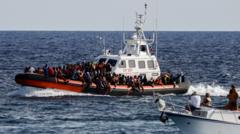In recent years, the European Union has witnessed a transformative shift regarding immigration policies. Once marginalized, far-right figures advocating for strict immigration controls have gained traction, leading to a convergence of attitudes among mainstream parties towards tougher immigration stances.
# Europe's New Firm Stance on Migration Reflects Political Shift

# Europe's New Firm Stance on Migration Reflects Political Shift
The EU's evolving immigration policies reflect a significant change across the political spectrum, similar to the hardline focus seen in the U.S.
As political sentiments change, the bloc is exploring policies that facilitate the deportation of undocumented migrants, sparking discussions reminiscent of past developments in the U.S.
Across Europe, nine years have marked a stunning transformation for politicians like Italian MEP Nicola Procaccini. Once considered a pariah due to his hard-line views on immigration, he now finds that his party's policies are becoming mainstream as the landscape of European politics shifts. The ascent of the Brothers of Italy party, under Prime Minister Giorgia Meloni, has catalyzed this transition, showcasing how right-wing narratives are beginning to resonate with broader audiences.
Today, an increasing number of centrist and left-leaning leaders are embracing migration policies that mirror those initially proposed by far-right factions. European nations are coalescing around an approach that prioritizes stricter measures against illegal migrants, drawing inspiration from Denmark’s zero-refugee policy and signaling a desire among many EU countries to enhance border controls.
The repercussions of this collective pivot are notable and may fundamentally reshape the continent’s migration landscape. Instead of triggers for societal unrest as seen with the Trump administration in the U.S., current changes in Europe appear more subdued but are nonetheless significant.
Statistics reveal that while irregular border crossings surged in the aftermath of the pandemic, recent trends indicate a decline. This change comes amidst ongoing negotiations within the EU regarding new frameworks for asylum seekers, such as a deal allowing agents to operate beyond EU borders in countries like Bosnia and Herzegovina. This tactic aims to bolster the EU’s ability to manage and control migration flows, thus further solidifying the shift towards a more hardline stance on immigration throughout Europe.
Thus, the political environment surrounding migration in Europe is rapidly evolving, with leaders from varying backgrounds rallying around strict immigration policies that reflect a deep-rooted change in public sentiment and political strategy.
Across Europe, nine years have marked a stunning transformation for politicians like Italian MEP Nicola Procaccini. Once considered a pariah due to his hard-line views on immigration, he now finds that his party's policies are becoming mainstream as the landscape of European politics shifts. The ascent of the Brothers of Italy party, under Prime Minister Giorgia Meloni, has catalyzed this transition, showcasing how right-wing narratives are beginning to resonate with broader audiences.
Today, an increasing number of centrist and left-leaning leaders are embracing migration policies that mirror those initially proposed by far-right factions. European nations are coalescing around an approach that prioritizes stricter measures against illegal migrants, drawing inspiration from Denmark’s zero-refugee policy and signaling a desire among many EU countries to enhance border controls.
The repercussions of this collective pivot are notable and may fundamentally reshape the continent’s migration landscape. Instead of triggers for societal unrest as seen with the Trump administration in the U.S., current changes in Europe appear more subdued but are nonetheless significant.
Statistics reveal that while irregular border crossings surged in the aftermath of the pandemic, recent trends indicate a decline. This change comes amidst ongoing negotiations within the EU regarding new frameworks for asylum seekers, such as a deal allowing agents to operate beyond EU borders in countries like Bosnia and Herzegovina. This tactic aims to bolster the EU’s ability to manage and control migration flows, thus further solidifying the shift towards a more hardline stance on immigration throughout Europe.
Thus, the political environment surrounding migration in Europe is rapidly evolving, with leaders from varying backgrounds rallying around strict immigration policies that reflect a deep-rooted change in public sentiment and political strategy.




















